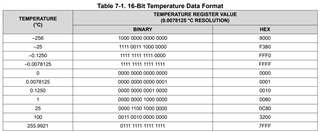We are using the smbus2 library in Python to read data coming from a TMP117 sensor. Using the .read_i2c_block_data() method we have printed out the sensor data. We observe the following array when we specify the block length as 3: [12, some number between 170 - 220, 255], and any increase in block length yields more 255’s. While these numbers must have something to do with the temperature measured by the sensor, it is unclear how to decipher the actual temperature value from these. We have looked through the data sheet and can not find a clear explanation as to how one should interpret the data. We are wondering if someone could provide insight into how to convert this output into temperature in degrees celsius. Thanks in advance!
-
Ask a related question
What is a related question?A related question is a question created from another question. When the related question is created, it will be automatically linked to the original question.


